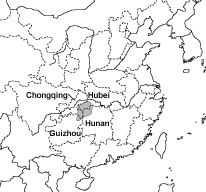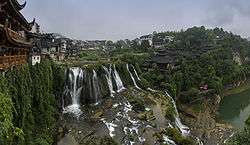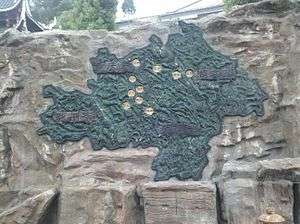Tujia people
| Total population | |
|---|---|
| approx. 8 million | |
| Regions with significant populations | |
 (Hunan · Hubei · Guizhou · Chongqing) | |
| Languages | |
|
Mandarin Chinese Tujia language (traditional) | |
| Religion | |
| Predominantly Nuoism |
The Tujia (Northern Tujia: Bifzivkar, IPA:pi˧˥ ʦi˥ kʰa˨˩; Southern Tujia: Mongrzzir, IPA: /mõ˨˩ ʣi˨˩/; Chinese: 土家族, pinyin: Tǔjiāzú), with a total population of over 8 million, is the 8th largest ethnic minority in the People's Republic of China. They live in the Wuling Mountains, straddling the common borders of Hunan, Hubei and Guizhou Provinces, and Chongqing Municipality.
The endonym Bizika means "native dwellers". In Chinese, Tujia means also "local", as distinguished from the Hakka (Chinese: 客家, Kèjiā) whose name implies wandering.[1]
Origins
Although there are different accounts of their origins, the Tujia may trace their history back over twelve centuries, and possibly beyond, to the ancient Ba people who occupied the area around modern-day Chongqing some 2,500 years ago. The Ba Kingdom reached the zenith of its power between 600 BC and 400 BC but was destroyed by the Qin in 316 BC. After being referred to by a long succession of different names in ancient documents, they appear in historical records as the Tujia from about 14th century onwards.
Ming and Qing Dynasties
The Tujia tusi chieftains reached the zenith of their power under the Ming Dynasty (1368–1644), when they were accorded comparatively high status by the imperial court. They achieved this through their reputation as providers of fierce, highly disciplined fighting men, who were employed by the emperor to suppress revolts by other minorities. On numerous occasions, they also helped defend China against outside invaders, such as the wokou ("Japanese" pirates) who ravaged the coast during the 16th century.
The Manchus invaded and conquered the Ming in 1644 and established the Great Qing Empire, known in China as the Qing Dynasty. Ever suspicious of local rulers, the Qing emperors always tried to replace Han officials with Manchu officials wherever they could. In the early 18th century, the Qing court finally felt secure enough to establish direct control over minority areas as well. This process, known as gaituguiliu (literally 'replace the local [ruler], return to mainstream [central rule]'), was carried out throughout south-west China gradually and, in general, peacefully. The court adopted a carrot-and-stick approach of lavish pensions for compliant chieftains, coupled with a huge show of military force on the borders of their territories.
Most of the Tujia areas returned to central control during the period 1728-1735. Whilst the Tujia peasantry probably preferred the measured rule of Qing officials to the arbitrary despotism of the Tujia chieftains whom they had replaced, many resented the attempts of the Qing court to impose national culture and customs on them. With the weakening of central Qing rule, numerous large-scale uprisings occurred culminating in the Taiping Rebellion which affected the area badly.
Recent history

Following the collapse of the Qing Dynasty, the Tujia found themselves caught between various competing warlords. More and more land was given over to the cultivation of high-earning opium at the insistence of wealthy landlords, and banditry was rife. After the founding of the People's Republic of China in 1949, Tujia areas came under Communist control, and banditry was rapidly eradicated. The Great Leap Forward led to mass famine in Tujia communities.
The Tujia were officially recognised as one of the 55 ethnic minorities in January 1957, and a number of autonomous prefectures and counties were subsequently established.
State Councillor Dai Bingguo, one of China's top officials on foreign policy, is the most prominent Tujia in the Chinese government.
Culture
Today, traditional Tujia customs can only be found in the most remote areas.
The Tujia are renowned for their singing and song composing abilities and for their tradition of the Baishou Dance (摆手舞), a 500-year-old collective dance which uses 70 ritual gestures to represent war, farming, hunting, courtship and other aspects of traditional life. They are also famous for their richly-patterned brocade, known as xilankapu, a product that in earlier days regularly figured in their tribute payments to the Chinese court.
Regarding religion, most of the Tujia worship a white tiger totem, although some Tujia in western Hunan worship a turtle totem.
Language
Tujia is a Tibeto-Burman language and is usually considered an isolate within this group, although it has grammatical and phonological similarities with Yi (though its vocabulary is very different).[2]
Today there are at most 70,000 native speakers of the Tujia language, most of whom live in the northern parts Xiangxi Tujia and Miao Autonomous Prefecture in north-western Hunan Province.
The vast majority of the Tujia use Chinese dialects (mainly Southwest Mandarin); a few speak Miao language. Few monolingual Tujia speakers remain; nearly all are bilingual in some dialect of Chinese. Children now learn Chinese from childhood and many young Tujia prefer to use Chinese when communicating among themselves. Among fluent Tujia speakers, Chinese borrowings, and even sentence structures, are more common.
Distribution
By province

The 2000 Chinese census recorded 8,028,133 Tujia in China.
- Provincial Distribution of the Tujia
| Province | Tujia Population | % of Total |
|---|---|---|
| Hunan | 2.639.534 | 32.88% |
| Hubei | 2.177.409 | 27.12% |
| Guizhou | 1.430.286 | 17.82% |
| Chongqing | 1.424.352 | 17.74% |
| Guangdong | 135.431 | 1.69% |
| Zhejiang | 55.310 | 0.69% |
| Sichuan | 41.246 | 0.51% |
| Fujian | 29.046 | 0.36% |
| Other | 95.519 | 1.19% |
In Chongqing, Tujia make up 4.67% of the total population; in Hunan, 4.17%; in Guizhou, 4.06%; in Hubei, 3.66%; and in Guangdong, 0.16%.
By county
- County-level distribution of the Tujia
(Only includes counties or county-equivalents containing >0.5% of China's Tujia population.)
| Province | Prefecture | County | Tujia Population | % of China's Tujia Population |
|---|---|---|---|---|
| Chongqing | Same | Youyang | 462,444 | 5.76% |
| Hunan | Zhangjiajie | Cili | 399,906 | 4.98% |
| Hubei | Enshi | Lichuan | 388,035 | 4.83% |
| Hunan | Changde | Shimen | 387,480 | 4.83% |
| Guizhou | Tongren | Yanhe Tujia Autonomous County | 383,499 | 4.78% |
| Chongqing | same | Shizhu | 348,790 | 4.34% |
| Hunan | Xiangxi | Yongshun | 342,570 | 4.27% |
| Hunan | Zhangjiajie | Yongding | 319,330 | 3.98% |
| Guizhou | Tongren | Dejiang | 300,432 | 3.74% |
| Hubei | Enshi | Xianfeng | 276,394 | 3.44% |
| Hubei | Enshi | Enshi | 270,753 | 3.37% |
| Chongqing | same | Qianjiang | 261,327 | 3.26% |
| Hunan | Zhangjiajie | Sangzhi | 260,092 | 3.24% |
| Hunan | Xiangxi | Longshan | 251,007 | 3.13% |
| Guizhou | Tongren | Yinjiang | 233,802 | 2.91% |
| Hubei | Enshi | Badong | 212,424 | 2.65% |
| Hubei | Yichang | Changyang | 211,129 | 2.63% |
| Chongqing | same | Xiushan | 197,570 | 2.46% |
| Hubei | Yichang | Wufeng | 174,546 | 2.17% |
| Hubei | Enshi | Jianshi | 173,984 | 2.17% |
| Guizhou | Tongren | Sinan | 160,089 | 1.99% |
| Hunan | Xiangxi | Baojing | 148,291 | 1.85% |
| Hubei | Enshi | Hefeng | 142,805 | 1.78% |
| Hubei | Enshi | Xuan'en | 140,837 | 1.75% |
| Hunan | Xiangxi | Jishou | 103,242 | 1.29% |
| Hunan | Huaihua | Yuanling | 102,636 | 1.28% |
| Hubei | Enshi | Laifeng | 93,471 | 1.16% |
| Guizhou | Tongren | Jiangkou | 77,791 | 0.97% |
| Chongqing | same | Pengshui | 74,591 | 0.93% |
| Guizhou | Tongren | Tongren | 70,286 | 0.88% |
| Hunan | Xiangxi | Fenghuang | 64,727 | 0.81% |
| Hunan | Xiangxi | Guzhang | 47,162 | 0.59% |
| Guizhou | Zunyi | Wuchuan | 46,253 | 0.58% |
| Hunan | Huaihua | Xupu | 45,900 | 0.57% |
| Hunan | Zhangjiajie | Wulingyuan | 41,910 | 0.52% |
| Hunan | Xiangxi | Luxi | 40,643 | 0.51% |
| Other | — | — | 771,985 | 9.62% |
Distribution
By county

- County-level distribution of the Tujia
(Only includes counties or county-equivalents containing >1% of county population.)
| By county/city | Tujia % | Tujia | Total |
| Longwan district | 1,24 | 2541 | 204935 |
| Hubei province | 3,66 | 2177409 | 59508870 |
| Yichang city | 10,26 | 425548 | 4149308 |
| Xiling district | 2,08 | 8876 | 427299 |
| Wujiagang district | 1,67 | 3068 | 184000 |
| Dianjun district | 2,20 | 1069 | 48612 |
| Xiaoting district | 1,56 | 824 | 52827 |
| Changyang Tujia autonomous county | 50,66 | 211129 | 416782 |
| Wufeng Tujia autonomous county | 84,77 | 174546 | 205897 |
| Yidu city | 3,47 | 13383 | 385779 |
| Songzi city | 1,08 | 9301 | 859941 |
| Enshi Tujia Miao autonomous prefecture | 45,00 | 1698703 | 3775190 |
| Enshi city | 35,83 | 270753 | 755725 |
| Lichuan city | 49,31 | 388035 | 786984 |
| Jianshi county | 34,08 | 173984 | 510555 |
| Badong county | 43,77 | 212424 | 485338 |
| Xuan'en county | 41,92 | 140837 | 335984 |
| Xianfeng county | 75,99 | 276394 | 363710 |
| Laifeng county | 29,51 | 93471 | 316707 |
| Hefeng county | 64,86 | 142805 | 220187 |
| Shennongjia district | 6,08 | 4758 | 78242 |
| Hu'nan province | 4,17 | 2639534 | 63274173 |
| Changde city | 7,07 | 405745 | 5740875 |
| Wuling district | 1,08 | 5508 | 509940 |
| Shimen county | 57,54 | 387480 | 673435 |
| Zhangjiajie city | 68,40 | 1021238 | 1493115 |
| Yongding district | 78,66 | 319330 | 405968 |
| Wulingyuan district | 87,76 | 41910 | 47755 |
| Cili county | 62,81 | 399906 | 636659 |
| Sangzhi county | 64,58 | 260092 | 402733 |
| Huaihua city | 3,49 | 162105 | 4639738 |
| Hecheng district | 1,50 | 5200 | 346522 |
| Yuanling county | 17,12 | 102636 | 599680 |
| Xupu county | 5,74 | 45900 | 798983 |
| Zhijiang Dong autonomous county | 1,63 | 5438 | 334229 |
| Xiangxi Tujia Miao autonomous prefecture | 41,12 | 1012997 | 2463617 |
| Jishou city | 35,08 | 103242 | 294297 |
| Luxi county | 15,82 | 40643 | 256869 |
| Fenghuang county | 18,82 | 64727 | 343878 |
| Huahuan county | 6,05 | 15355 | 253750 |
| Baojing county | 57,03 | 148291 | 260034 |
| Guzhang county | 39,56 | 47162 | 119202 |
| Yongshun county | 76,94 | 342570 | 445224 |
| Longshan county | 51,19 | 251007 | 490363 |
| Sanshui city | 1,41 | 6201 | 440119 |
| Chongqing municipality | 4,67 | 1424352 | 30512763 |
| Districts under the municipality | 3,00 | 291073 | 9691901 |
| Wanzhou district | 1,12 | 18390 | 1648870 |
| Qianjiang district | 59,07 | 261327 | 442385 |
| Counties under the municipality | 6,88 | 1132068 | 16460869 |
| Fengdu county | 1,43 | 11054 | 774054 |
| Zhong county | 1,36 | 12985 | 954075 |
| Fengjie county | 1,38 | 12021 | 871743 |
| Shizhu Tujia autonomous county | 71,93 | 348790 | 484876 |
| Xiushan Tujia Miao autonomous county | 38,93 | 197570 | 507522 |
| Youyang Tujia Miao autonomous county | 77,81 | 462444 | 594287 |
| Pengshui Miao Tujia autonomous county | 12,64 | 74591 | 590228 |
| Xuanhan county | 2,95 | 30891 | 1047230 |
| Guizhou province | 4,06 | 1430286 | 35247695 |
| Nanming district | 1,58 | 10896 | 687804 |
| Yunyan district | 1,21 | 8447 | 698988 |
| Baiyun district | 1,24 | 2319 | 187695 |
| Zunyi city | 1,54 | 100454 | 6543860 |
| Daozhen Gelao Miao autonomous county | 6,07 | 17404 | 286715 |
| Wuchuan Gelao Miao autonomous county | 11,98 | 46253 | 386164 |
| Fenggang county | 6,48 | 24005 | 370253 |
| Yuqing county | 1,63 | 4128 | 252965 |
| Tongren prefecture | 37,81 | 1248696 | 3302625 |
| Tongren city | 22,78 | 70286 | 308583 |
| Jiangkou county | 41,10 | 77791 | 189288 |
| Yuping Dong autonomous county | 1,29 | 1628 | 126462 |
| Shiqian county | 1,62 | 5425 | 334508 |
| Sinan county | 29,46 | 160089 | 543389 |
| Yinjiang Tujia Miao autonomous county | 69,74 | 233802 | 335263 |
| Dejiang county | 77,30 | 300432 | 388639 |
| Yanhe Tujia autonomous county | 80,85 | 383499 | 474331 |
| Songtao Miao autonomous county | 2,59 | 14190 | 547488 |
| Wanshante district | 2,84 | 1554 | 54674 |
| Qiandongnan Miao Dong autonomous prefecture | 1,03 | 39512 | 3844697 |
| Zhenyuan county | 5,04 | 11227 | 222766 |
| Cengong county | 10,40 | 19524 | 187734 |
Autonomous Areas Designated for Tujia
Famous Tujia
External links
Bibliography
- Brown, M.J. (2001). "Ethnic Classification and Culture: The Case of the Tujia in Hubei, China," Asian Ethnicity 2(1): 55-72.
- Brown, M.J. (2004). "They Came with Their Hands Tied behind Their Backs" - Forced Migrations, Identity Changes, and State Classification in Hubei. Is Taiwan Chinese? (pp. 166–210). Berkeley: University of California Press.
- Brown, M.J. (2007). "Ethnic Identity, Cultural Variation, and Processes of Change - Rethinking the Insights of Standardization and Orthopraxy". Modern China. 33(1): 91-124. Sage Publications.
- ---- 2002. "Local Government Agency: Manipulating Tujia Identity," Modern China.
- Ch'en, J. (1992). The Highlanders of Central China: A History 1895-1937. New York: M.E. Sharpe.
- Dong, L. (1999). Ba feng Tu yun—Tujia wenhua yuanliu jiexi (Ba Manners, Tu Charm—An Analysis of the Origins of Tujia Culture). Wuhan: Wuhan Daxue Chubanshe.
- Dong, L., Brown, M.J., Wu, X. (2002). Tujia. Encyclopedia of World Cultures - Supplement. C. Ember, M. Ember & I. Skoggard (eds.), NY: Macmillan Reference USA, pp. 351–354.
- Huang B. (1999). "Tujiazu Zuyuan Yanjiu Zonglun" ("A Review of Research on Tujia Ancestral Origins"). In Tujia zu lizhi wenhua lunji (A Colloquium on Tujia History and Culture), edited by Huang Baiquan and Tian Wanzheng. 25-42. Enshi, Hubei: Hubei Minzu Xueyuan.
- Li, S. (1993). Chuandong Youshui Tujia (Tujia of the Youshui River in East Sichuan). Chengdu: Chengdu Chubanshe.
- Peng, B., Peng, X. et al. (1981). Jishou University Journal, Humanities Edition #2: Special Issue on Tujia Ethnography [in Chinese]. Jishou: Jishou University.
- Shih C. (2001). "Ethnicity as Policy Expedience: Clan Confucianism in Ethnic Tujia-Miao Yongshun," Asian Ethnicity 2(1): 73-88.
- Sutton, D. (2000). "Myth Making on an Ethnic Frontier: The Cult of the Heavenly Kings of West Hunan, 1715-1996," Modern China 26(4): 448-500.
- Sutton, D. (2003). "Violence and Ethnicity on a Qing Colonial Frontier: Customary and Statutory Law in the Eighteenth-Century Miao Pale". In: Modern Asian Studies 37(1): 41–80. Cambridge University Press.
- Sutton, D. (2007). "Ritual, Cultural Standardization, and Orthopraxy in China: Reconsidering James L. Watson’s Ideas". In: Modern China 33(1): 3-21. Sage Publications.
- Tien, D., He, T., Chen, K., Li, J., Xie, Z., Peng, X. (1986). Tujiayu Jianzhi (A Brief Chronicle of the Tujia Language). Beijing: Minzu Chubanshe.
- Wu, X. (1996). "Changes of chieftains' external policy in the Three Gorges Area in the late Ming and early Qing dynasties [1630s-1660s]". In: Ethnic Forum, (3): 88-92. (Hunan, China)
- Wu, X. (1997). "Tujia's food-getting pattern in west Hubei in the Qing Dynasty". In: Journal of Hubei Institute for Nationalities, (2): 33-35. (Hubei, China)
- Wu, X. (1997). "On the Tage Dance". In: Journal of Chinese Classics and Culture, (2): 22-29. (Beijing, China)
- Wu, X. (2003). "Food, Ethnoecology and Identity in Enshi Prefecture, Hubei, China". (Doctoral Dissertation, University of Alberta, 388 pages).
- Wu, X. (2003). "Turning Waste into Things of Value": Marketing Fern, Kudzu and Osmunda in Enshi Prefecture, China. In: Journal of Developing Societies, 19(4): 433-457.
- Wu, X. (2004). "Ethnic Foods" and Regional Identity: the Hezha Restaurants in Enshi. In: Food and Foodways, 12(4): 225-246.
- Wu, X. (2005). "The New Year's Eve Dinner and Wormwood Meal: Festival Foodways as Ethnic Markers in Enshi". In: Modern China, 31(3): 353-380.
- Wu, X. (2006). "Maize, Ecosystem Transition and Ethnicity in Enshi Prefecture, China". In: East Asian History, 31(1): 1-22.
- Wu, X. (2010). "Tujia National Minority". Berg Encyclopedia of World Dress and Fashion.
- Ye, D. (1995). Tujiayu yanjiu (Studies of the Tujia Language). Jishou, Hunan: Hunan Chu Wenhua Zhongxin, Jishou Daxue.